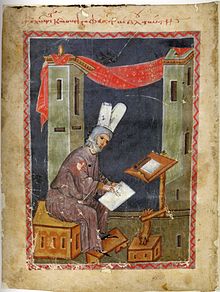Niketas Choniates
This article includes a list of general references, but it lacks sufficient corresponding inline citations. (July 2023) |
Niketas Choniates | |
|---|---|
| Νικήτας Χωνιάτης | |
 Choniates in an ancient manuscript | |
| Born | c. 1155 |
| Died | 1217 (aged 61–62) |
| Occupations |
|
| Family | Michael Choniates (brother) |
Niketas or Nicetas Choniates (Medieval Greek: Νικήτας Χωνιάτης; c. 1155 – 1217), whose actual surname was Akominatos (Ἀκομινάτος), was a Byzantine Greek historian and politician. He accompanied his brother Michael Akominatos to Constantinople from their birthplace Chonae (from which came his nickname, "Choniates" meaning "person from Chonae"). Nicetas wrote a history of the Eastern Roman Empire from 1118 to 1207.
Life
[edit]Nicetas Akominatos was born to wealthy parents around 1150 in Phrygia in the city of Chonae (near the modern Honaz in Turkey). Bishop Nicetas of Chonae baptized and named the infant; later he was called "Choniates" after his birthplace. When he was nine, his father dispatched him with his brother Michael to Constantinople to receive an education. Niketas' older brother greatly influenced him during the early stages of his life.
He initially secured a post in the civil service, and held important appointments under the Angelos emperors (among them that of Grand Logothete or Chancellor) and was governor of the theme of Philippopolis at a critical period. After the sack of Constantinople during the Fourth Crusade in 1204, he fled to Nicaea, where he settled at the court of the Nicaean emperor Theodore I Lascaris, and devoted himself to literature. He died in 1217.
His theological work, Thesaurus Orthodoxae Fidei, although extant in a complete form in manuscripts, has been published only in part. It is one of the chief authorities for the heresies and heretical writers of the 12th century.
Choniates in fiction
[edit]Umberto Eco's novel Baudolino[1] is set partly at Constantinople during the Crusader conquest. The imaginary hero, Baudolino, saves Niketas during the sacking of Constantinople, and then proceeds to confide his life story to him.
Niketas is a major character in Alan Gordon's murder mystery A Death in the Venetian Quarter (New York: St. Martin's Minotaru, 2002).
Editions and translations
[edit]- Imperii Graeci Historia, ed. Hieronymus Wolf, 1557, in Greek with parallel Latin translation. (PDF of 1593 reprint)
- Nicetæ Choniatæ Historia, ed. J.P. Migne (Patrologia Graeca vol. 140) reproduces Wolf's text (in more modern type) and translation (in standardized spelling). (PDF)
- Nicetae Choniatae Historia, ed. Immanuel Bekker, Bonn (CSHB), 1835, with Wolf's translation at the bottom of the page. (at the Internet Archive)
- Nicetae Choniatae Historia, ed. Jan Louis van Dieten, Berlin (CFHB #11), 1975 (ISBN 3110045281).
- O City of Byzantium: Annals of Niketas Choniates, trans. Harry J. Magoulias, 1984 (ISBN 0814317642). (PDF)
References
[edit]- ^ Milan: Bompiani, 2000. English translation by William Weaver, New York: Harcourt 2002, ISBN 0-15-100690-3
Further reading
[edit]- Brand, Charles M. (1968). Byzantium Confronts the West, 1180–1204. Cambridge, Massachusetts: Harvard University Press. LCCN 67-20872. OCLC 795121713.
- Harris, Jonathan, Byzantium and the Crusades, Bloomsbury, 2nd ed., 2014. ISBN 978-1-78093-767-0
- Harris, Jonathan. 'Distortion, divine providence and genre in Nicetas Choniates' account of the collapse of Byzantium 1180–1204', Journal of Medieval History, vol. 26 (2000) 19–31.
- Simpson & Efthymiadis (edd.). Niketas Choniates: A Historian and a Writer, 2009, ISBN 978-954-8446-05-1
- Vasilikopoulou, Agni (1969). "Ἀνδρόνικος ὁ Κομνηνὸς καὶ Ὀδυσσεύς". Ἐπετηρίς Ἐταιρείας Βυζαντινῶν Σπουδῶν (in Greek). 37: 251–259. A seminal work on Choniates' use of Homer.
External links
[edit]- Excerpt in English on the Sack of Constantinople in 1204.
- A longer excerpt on the same.
- This article incorporates text from a publication now in the public domain: Chisholm, Hugh, ed. (1911). "Acominatus, Michael". Encyclopædia Britannica (11th ed.). Cambridge University Press.
